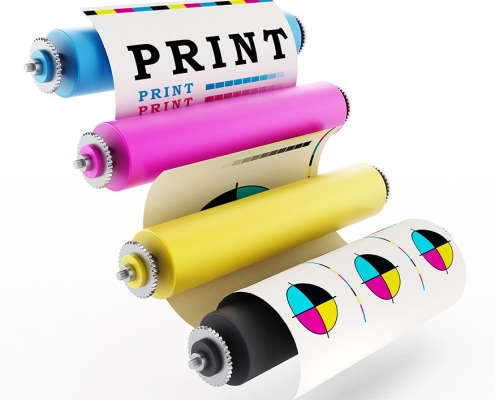Traditional Print vs. Digital Print… and How Data is the Darling of Digital Print
By Marley Niesz
Having recently started my career here at CCG as a Marketing Solutions Specialist, I quickly learned — there’s a lot to learn — about print! As a University of Maryland graduate with a BS in Marketing, I can talk “marketing” all day. But what about print? My idea of print was the barely-functioning printer that resided in my college apartment for four years. If I’m being honest, it probably functioned fine, I think I was always too lazy to change the ink cartridges!
My training here at CCG began on day one as I toured the company and heard familiar terms like “sheet-fed print”, “web print”, and “digital print”. I knew that these terms represented different types of print capabilities, and I could tell you which print equipment functioned as a digital press vs. a traditional press, but how do you know which is the best choice for a print project? And how the heck did printing get to where it is today—printing thousands of full-color personalized pages in an hour? So, I went on a mission to understand the difference between digital and traditional print. That’s where this blog begins.
If you’ve ever walked through the print manufacturing floor in awe of the paper rolls feeding the press at an impressive 3,000 feet/minute, or the sheet-fed presses spitting out perfect hi-resolution press sheets at 9,000 sheets per hour, you can thank an American named Ira Washington Rubel, who accidentally invented the first modern offset press. In 1903, Rubel realized that when he failed to insert paper into his lithographic press, the metal plate automatically transferred the image onto the rubber impression cylinder. When he ran paper through the machine afterwards, the image appeared on both sides, with the rubber cylinder producing a higher quality image. Thus, the traditional sheet-fed printing process as we know it today, was born.
Other inventions have led to the groundbreaking distinctions featured in the traditional offset and web presses of today. For example—a few years after Ira Rubel’s discovery, the CMYK four-color ink process of printing was developed by the Eagle Printing Ink Company. In 1951, the first continuous inkjet printing press was patented by Siemens, and later developed further by Ichiro Endo of Japan, who worked for Canon at the time. These inventions added to the ease, speed, and quality of manufacturing. But what does traditional offset printing look like today?
CCG’s offset presses include models from Heidelberg, Manroland, and Didde, representing a variety of sheet-fed and web print technology. However, all operate in a traditional offset manner, meaning they image and process a “plate” in the prepress department, hang the plate on the press, and the image is transferred in the print process onto a rubber blanket and then onto the paper. Offset printing becomes the most cost-effective choice when manufacturing larger volumes.
Back to CMYK. Although we view things in a digital environment (i.e. a desktop monitor) in RGB, offset print achieves its color gamut by using CMYK inks (referenced earlier). Cyan, magenta, yellow and black are the four primary process colors, but can be mixed in certain ratios to produce thousands of custom “spot” colors by using the Pantone Matching System (PMS).
Digital Print began in the early 1990s when the Indigo, the world’s first digital color printing press, was released. This completely transformed the world of print, allowing for offset-quality, short-run, personalized print. The process takes a digital file and assembles it into pixels to recreate the image. The press then reproduces the file on paper using a color management system which balances ink, toner, and exposure to replicate the exact image from the digital file onto the paper stock. Advantages of digital print include quick turnaround, efficiency of scale for shorter print runs, and variable image and data print.
The single biggest benefit of digital printing is the ability to personalize (or version) any project, producing a single custom-printed piece with each sheet printed. Think—direct mail pieces each with custom images, offers, messaging, and personalization printed in one press run. The technology is truly inspiring, the quality is that of traditional offset print, and the variable data and imaging possibilities per piece are endless.
Deciding between the two methods is on a job-by-job basis. Organizations such as foundations and non-profits who rely on the generosity of donors should leverage the flexibility of digital printing. They can design their direct mail to include donor data and each campaign can be entirely personalized using the data they provide. This is key to capturing the interest of benefactors. These are all important things to consider, but now I want to talk about everyone’s favorite four-letter word, and digital printing’s best friend—data.
If you’re a marketer and you are not currently harnessing the power of data in print, you might as well order some Botox now because you’re looking old and crusty. Kidding, of course, but the possibilities with data are literally infinite. If you are wondering how your twenty-something year old employee got so good at stalking out leads on the internet, finding information on a customer’s exact preferences, locations, future plans, and other obscure details, it’s not because of anything we learned in school. It’s because we’ve been doing the same thing with our exes for years! But I have a little secret. You can do the same exact thing for your target audience using the power of data.
Retailers and the government have been stalking us and collecting our data for years. It’s time for print marketers to do the same thing. Just like Nordstrom’s sending my mom purchase recommendations in her email moments after she buys ANOTHER pair of shoes, you can send your customers hyper-targeted direct mail specific to what they looked at online. (It’s called retargeting, and I’ll write a blog on that in the near future.) With our inkjet printer and your data, CCG can print and send a self-mailer to a consumer with the exact jacket they had in their online shopping cart two days earlier. Imagine the power this holds. Who wants to receive a travel book about all seven continents when they’re only planning a trip to Italy? Why not print the book to be personalized to every consumer’s individual upcoming trip? This can be printed in one process with variable data and digital print. For one moment, think about the possibilities. Sport’s Illustrated could have their magazine printed so that each subscriber only receives a copy with the sports that they indicated interest in. There are millions of books, magazines, and papers sitting in a landfill right now because marketers failed to consider variable print and print-on-demand options for their direct mail projects. Covid-19 rendered a large amount of static direct mail unusable as marketers realized they could no longer advertise the same services, products, or messages due to COVID-19. What if they could have changed the messaging or the offer right before it went to press to reflect the changing times and the current situation? The point is, people are a lot less likely to throw something out if it’s made exactly for them. And that could translate into more business for you. He who can print the cheapest is no longer selling the most. The winner is the marketer who knows how to use data and digital print to increase conversions and ROI, and print and mail highly targeted and relevant direct mail to the right audience at the right time.
Maybe I’m a nerd for getting a little adrenaline rush every time I walk the pressroom floor and see all of these machines at work, but I hope after reading this you are a little more excited about how far print has advanced—and how far it will continue to go (especially because of data). Let’s have a conversation today about how Corporate Communications Group can serve you—digitally or traditionally.



